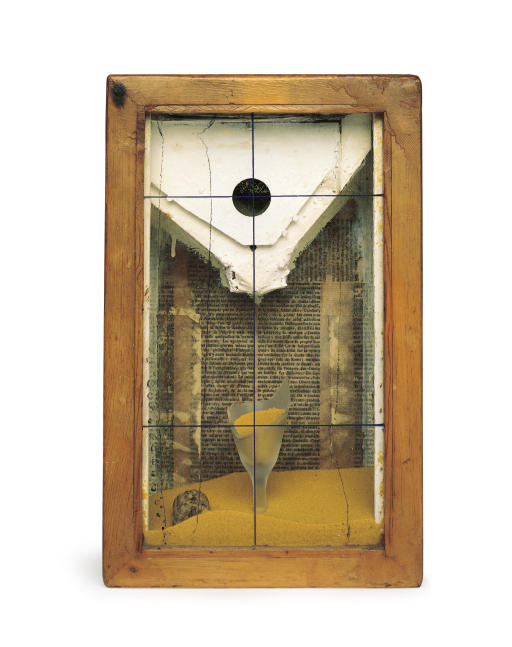
In the simple tumble of sand from the top of Sand Fountain into a broken glass, echo memories of egg timers, of Victorian sand toys, of penny arcades. This work combines fun and fatalism. The finite amount of sand implies a finite amount of time, making Sand Fountain a modern vanitas, a reminder of our mortality. This is emphasised by the fragility of the glass, which stands broken, a cracked vessel incapable of truly capturing the fleeting sands of time. This appears to be a metaphor for life, but it is one in which Cornell asks the viewer to participate. Works such as this bring the importance of the viewer's physical interaction with Cornell's works to the fore. We are required to become involved with this box, to do more than merely view. Cornell designed Sand Fountain to be taken from its place, turned upside down in order to recharge the compartment at the top, and then tipped once more in order for the sand to fall down again. We are meant to contemplate it, but also to play with it. It is no coincidence that Cornell once even had an exhibition of his works that was designed specifically for children. A childlike wonder is at work in this box, as well as a poignant poetry.
Here we truly see the embodiment of Cornell's own description of his boxes:"Perhaps a definition of a box could be as a kind of 'forgotten game,' a philosophical toy of the Victorian era, with poetic or magical 'moving parts', achieving even slight measure of this poetry or magic...that golden age of the toy alone should justify the 'box's' existence" (J. Cornell, quoted in D. Ades, "The Transcendental Surrealism of Joseph Cornell," pp. 15-41, Joseph Cornell, exh. cat., New York, 1980, p. 29).It is only too apt, considering the central theme of time's passage in Sand Fountain, that Cornell has made it so evocative of days of yore. Cornell conjures a deliberately antiquated atmosphere by including opaque, broken glass, which appears frosted with time, and also the antique page of French text that papers the back. This links Sand Fountain to the past, to Cornell's beloved French culture and literature, to travel, to his friend Marcel Duchamp -- in short, to his own personal memories. Sand Fountain therefore comes close to crystallizing and capturing, behind glass like some specimen, the intimate and the ineffable.


![[.tze]](http://1.bp.blogspot.com/_dpptJHtg3BU/Sz-zNYSKitI/AAAAAAAATos/ZBDlnvRfrPI/S1600-R/ver+3.jpg)













